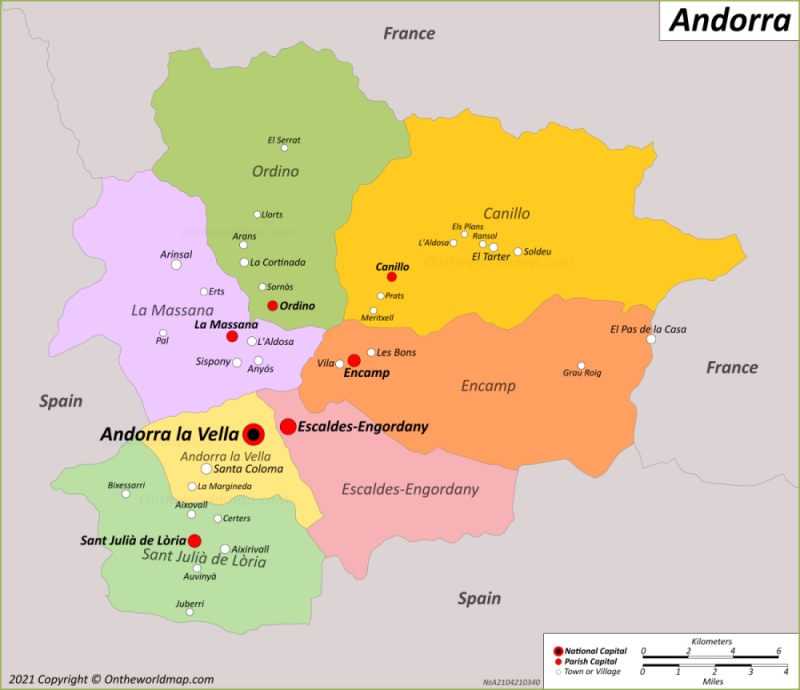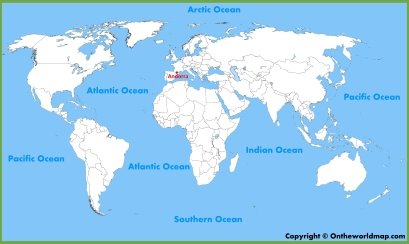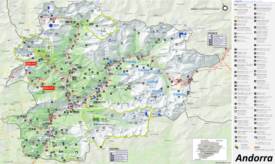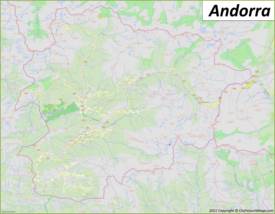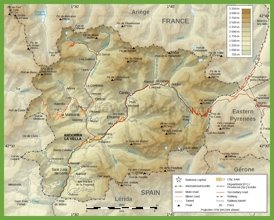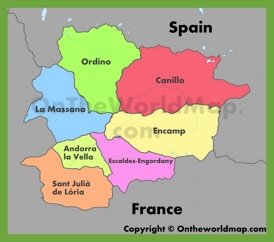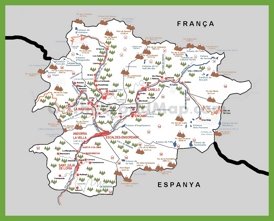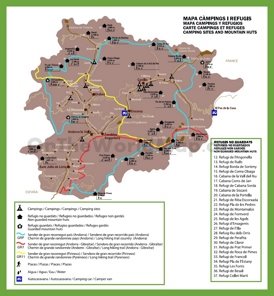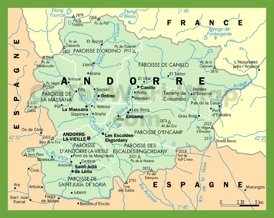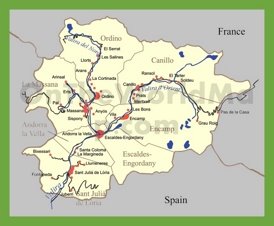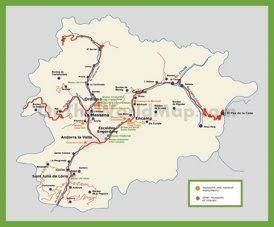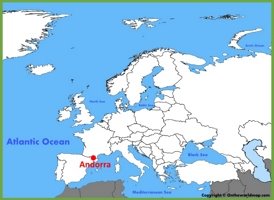Andorra Map
Description:
This map shows governmental boundaries of countries; parishes, parish capitals, major cities and towns in Andorra.
Size: 1600x1378px / 394 Kb
Author: Ontheworldmap.com
You may download, print or use the above map for educational, personal and non-commercial purposes. Attribution is required. For any website, blog, scientific research or e-book, you must place a hyperlink (to this page) with an attribution next to the image used.
Online Map of Andorra
About Andorra
Andorra is a small landlocked principality in Southwestern Europe, located in the eastern Pyrenees and bordered by France to the north and Spain to the south. Andorra covers an area of about 468 square kilometers (181 sq mi) and is one of the smallest countries in Europe.
Andorra la Vella, the capital and largest city, serves as the political, economic, and cultural center. Other significant towns include Escaldes-Engordani, known for its thermal baths, and Encamp, a winter sports center.
Tourism is the most important component of Andorra's economy, attracting visitors with its spectacular scenery and winter sports opportunities. The Principality offers numerous ski resorts, such as Grandvalira and Vallnord, which provide opportunities for skiing, snowboarding and other winter sports.
In addition to winter sports, tourists are attracted year-round by Andorra's duty-free shopping and cultural attractions such as Romanesque churches and the Madriu Perafita Claror Valley, a UNESCO World Heritage Site.
Andorra maintains a stable political system and a thriving economy driven by tourism, banking and retail trade. The Principality has sought to diversify its economy and strengthen international relations, joining the United Nations in 1993 and the Council of Europe in 1994.
Despite its small size, Andorra plays an active role in regional and international affairs, balancing historical traditions with modern development. The country's commitment to preserving its cultural heritage, combined with its natural beauty, continues to attract tourists and contribute to its unique identity in the heart of the Pyrenees.
The Facts:
Capital: Andorra la Vella.
Area: 180.55 sq mi (467.63 sq km).
Population: ~ 82,000.
Official language: Catalan.
Currency: Euro (€) (EUR).
Cities and Towns: Andorra la Vella, Les Escaldes, Sant Julià de Lòria, Encamp, La Massana, Santa Coloma, Ordino, Canillo, El Pas de la Casa, Arinsal.
Parishes of Andorra: Andorra la Vella, Canillo, Encamp, Escaldes-Engordany, La Massana, Ordino, Sant Julià de Lòria.
Driving side: right.
Calling code: +376.
Internet TLD: .ad.
Time zone: UTC+01 (CET), Summer (DST) UTC+02 (CEST).
Website: www.govern.ad.
Google Map of Andorra
Geography of Andorra
Geographically, Andorra is a mountainous area characterized by narrow valleys and high peaks, the highest point of which, Coma Pedrosa, is at an altitude of 2,942 meters.
The rugged landscape influences the country's climate, which varies according to altitude. Andorra has a temperate climate with cold snowy winters and mild summers in the valleys. The high altitude areas receive a lot of snowfall, which favors the winter sports industry.
Brief History of Andorra
Historically, Andorra has its origins in the early Middle Ages. In 805, Charlemagne granted a charter to the Andorrans, recognizing their role in resisting Moorish invasions. In 1278, as a result of the signing of the Pareage, Andorra became a joint principality under the joint sovereignty of the Count of Foix (later head of state of France) and the Bishop of Urgell in Spain. This unique political arrangement persisted for centuries, with the President of France and the Bishop of Urgell serving as co-princes.
Andorra remained relatively isolated until the 20th century, when improved infrastructure and tourism spurred economic growth. In 1993 Andorra adopted its first constitution, moving from a feudal system to a parliamentary democracy while retaining its status as a co-princely state. The constitution established a legislative body, the General Council, and reaffirmed the rights and freedoms of citizens.

